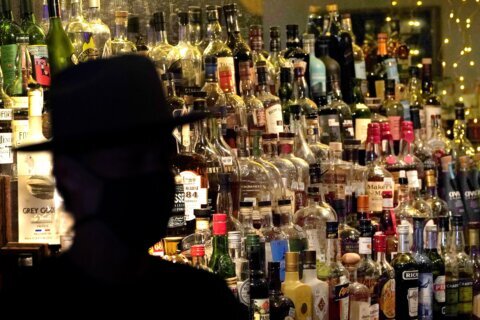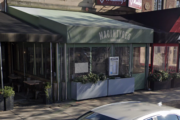Many of us can’t wait for Monday afternoon’s solar eclipse — and in 2024, you can bet a lot will want to share smartphone photos of the experience on social media.
As we all (should) know, looking directly at the sun during an eclipse can cause immediate and possibly permanent eye damage. NASA has a guide for eye safety during a total solar eclipse, but in our area, the totality is expected to be around 90%.
And while professional photographers will be using expensive cameras, lenses and filters to capture the moment, the old adage says the best camera is the one you have with you — the smartphone.
Regardless of the brand or operating system of the smartphone, with the sun being 92 million miles from earth, there’s zero chance of a crisp, clear close-up — and if you tried to achieve that, you’ll destroy your phone.
So, with that, here are WTOP’s “5 tips for taking smartphone photos during Monday’s solar eclipse.”
Protect your eyes and phone
There’s nothing inherently more dangerous about looking at the sun during an eclipse than on any other day. On a non-eclipse day, if you happen to glance directly at the sun, it’s uncomfortably bright, and you look away.
But, since the next time the U.S. will experience a coast-to-coast total solar eclipse is 2045, FOMO might put your vision — and phone — at risk.
More on the solar eclipse:
- What to know about next week’s total solar eclipse in the US, Mexico and Canada
- Not in the path of totality? You can still watch Monday’s total solar eclipse online
- Blind people can hear and feel April’s total solar eclipse with new technology
Those eager to experience the eclipse should buy eclipse glasses from a reputable vendor. Sunglasses are not protective enough, and binoculars and telescopes without a proper solar filter can magnify light from the sun, making them unsafe.
Same for your camera. Don’t take photos or videos looking directly at the sun and moon for anything longer than the briefest glance, according to experts.
So, how are you supposed to take pictures?
Put safety glasses on your phone
The same inexpensive, but vital glasses that comply with ISO 12312-2 standards that protect your eyes from retinal damage can also protect your phone’s digital innards.
So, have a second set of eclipse safety glasses handy to put directly in front of your phone’s camera lens, while you’re looking through the phone’s viewfinder wearing your safety glasses.
It may be difficult to juggle the cardboard frames, and point the camera through the lens, and it may look dorky. OK, it does look dorky. But it’s safe.
Another option, if you have enough cardboard safety glasses to go around, would be to cut the earflaps off a cardboard frame, and position and lightly tape a safety lens to your phone case.
Today @WTOP: 5 tips for taking smartphone photos during Monday’s solar eclipse. pic.twitter.com/cLfWqKJkiE
— Neal Augenstein (@AugensteinWTOP) April 4, 2024
Don’t zoom in
While smartphone cameras, lenses, sensors continue to improve — including artificial intelligence — there are limits to what it can accomplish.
Avoid the urge to zoom in. Pinching and zooming on a smartphone to place the sun and moon in the center of the frame will result in a pixilated image, says D.C. based photographer Bill Crandall, who has offered general tips on smartphone photography.
While the sun and moon will look small, including the landscape where you’re viewing the eclipse — for instance, a tree branch — can help create a memorable photo.
“If the action or main subject is visible, but too far away, play with using a foreground element to create depth. Put something very close to the camera, juxtaposed against what is far away.
Steady
Any smartphone photograph can be ruined by a jiggle or unintended movement right before or after you snap the picture.
With the sun and moon so far away, an inexpensive tripod can help lessen the chance of a blurred photo. But just pressing the digital shutter on a smartphone can cause a tiny amount of movement.
Most smartphone cameras include a timer, to increase the amount of time between when the button is pressed and when the image is captured. And unlike events where a photographer attempts to capture a specific instant, each stage of the eclipse will last long enough to place the phone in the tripod and activate a timed photo.
While smartphones offer automatic adjustments to ensure the best quality, experts suggest manually focusing and adjusting what the camera is seeing.
Capture the moment
The excitement of the first coast-to-coast total solar eclipse since 2017 will be captured by professional photographers and NASA, so perhaps you might want to point your smartphone toward people around you, rather than just the sun and moon.
Pictures of families and strangers gathered together with safety glasses on, peering toward the eclipse would likely be a far more compelling documentation of the moment.
“Focus on people’s reactions and emotions around you – not just your friends and family, but even strangers probably won’t mind if you take their picture,” said Crandall.
And, face it, a well-taken photograph of people around you will stand out from the typical far-away photos that most of us share on social media.
In fact, Crandall recalls an image taken during President Ronald Reagan’s funeral procession in 2004.
“Everyone in the crowd had their phone raised high to take a picture. It was a pretty remarkable commentary about how we experience events like these, nowadays.”
Get breaking news and daily headlines delivered to your email inbox by signing up here.
© 2024 WTOP. All Rights Reserved. This website is not intended for users located within the European Economic Area.








